Which birds might I see today? Osprey
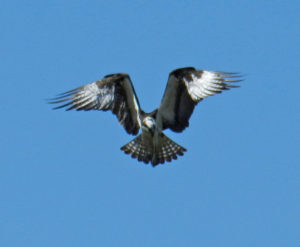
Which of us has not thrilled to the sight of an Osprey hovering over the lake, then diving down with feet outstretched to catch a fish and fly off triumphantly with it? I never tire of watching the performance; the search, the plummet, the powerful wingbeats as the bird rises with its prey. Our summers are enriched by the presence of these majestic birds.
The Osprey is the only bird of prey in North America that feeds almost exclusively on fish, thus earning it the nickname of “fish hawk” or “fish eagle”.
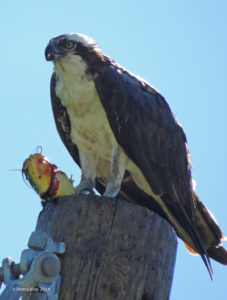
Neither eagle nor hawk, an Osprey is nonetheless a large impressive raptor, 21 – 23”/53-58 cm in size, with a wingspan of 5 – 6 ft/1.5 – 1.8 metres. The bird has a dark brown back, a black eye stripe on a white head, and a hooked beak, and looks pale underneath when seen from below.
The wings always look curved when the bird is soaring. Tiny spike-like growths on the bird’s feet, front toes which face backwards (uniquely), and an ability to lock its talons in place enable it to hold onto slippery fish. When the fish has been plucked from the water, the bird turns it to face forward, head first, to reduce drag. It then carries it back to a safe perch or the nest site, looking to me almost as if it’s riding a skateboard.
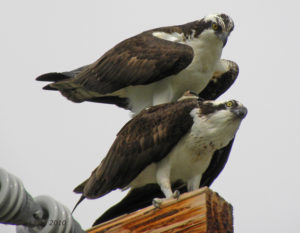
Ospreys breed in a wide variety of habitats; northern forests, near shallow reservoirs, along freshwater rivers and large lakes, estuaries and salt marshes and are found all across Canada in summer except in the high Arctic. Threatened at one time in the mid-twentieth century by DDT sprays, which weakened the egg shells drastically reducing survival rates of hatchlings, the species has made a good recovery now that such chemicals are no longer used. The birds also have a high tolerance for nearby human activity, and will use artificial nest sites on busy roads such as Benvoulin in Kelowna, without any apparent distress.
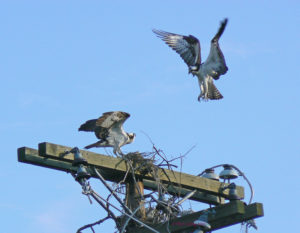
Ospreys lay 1 to 4 eggs annually, raising one brood. Usually only two or at most three chicks survive, as long as there is a good supply of nearby fish. The male does most of the fishing during incubation, feeding the female on the nest. The female then feeds the chicks, which hatch on different days. Sometimes the older, stronger nestlings push the youngest, weakest one out of the nest.
Have you noticed that Ospreys decorate their nests? One nest used annually in Osoyoos is festooned with binder twine from haybales, dangling dangerously below the nest. One year a chick became caught in this twine but fortunately was rescued when a birder reported it, a lucky escape. A safer decorative element might be lawnmower parts, or even Barbie dolls, both of which have been observed!
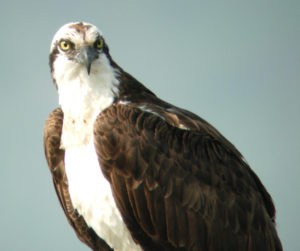
It is my understanding that Ospreys migrate separately, male and female wintering in different places. The grown chicks are left to fend for themselves for a month to six weeks before they too head south, usually sometime in September. In spring the parent birds return to the same nest site. Usually the female comes north first, and her mate will join her within two to three weeks. How do they do it? There are still many mysteries in the bird world.
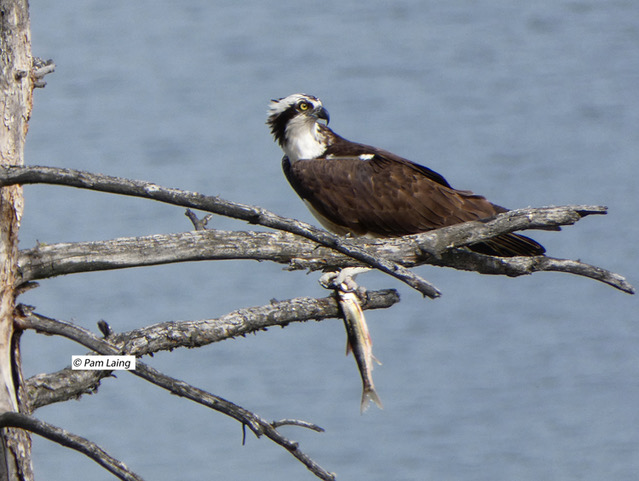
Pam Laing, Okanagan birder







Duane
I also love to watch the Ospreys fishing in our lakes. I don’t recall seeing them when I was young; I assumed that they were a high elevation bird. Has their habitat changed?
I observed one situation when an Osprey was having difficulty handling his catch. He had landed on the top of a telephone pole to rest but could not take off because the fish was dangling over the side of the pole and he faced too much resistance for take-off. So, he ate part of the fish, tried again to fly away with no success, ate some more and had to repeat the process a few more times before he was able to become airborne without loss of his food. Not much of that fish got back to his nest to share with his family.
Duane
Wonderful photos and description Pam. I always look forward to your quarterly contribution to this blog.